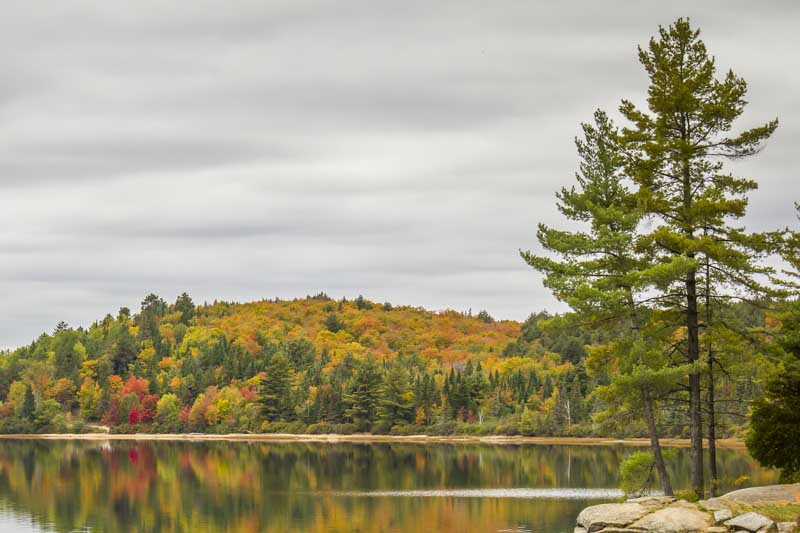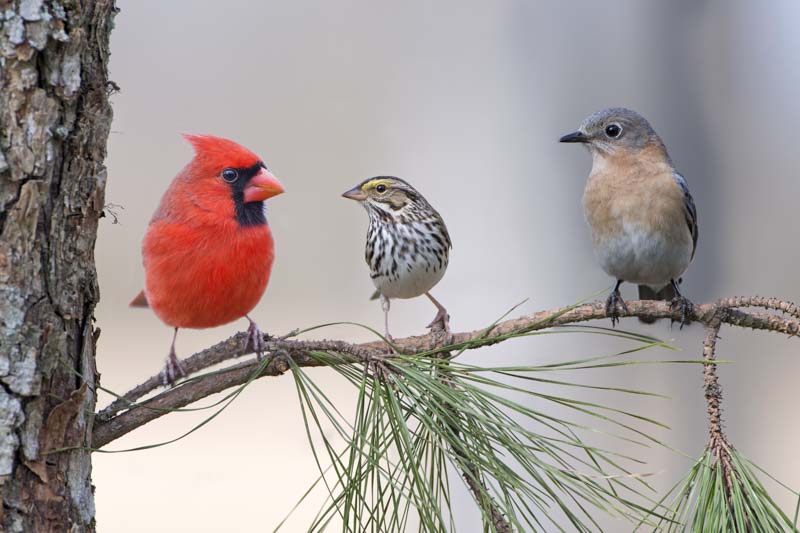Eastern White Pine, Weymouth Pine, North American Pumpkin Pine, North American White Pine, White Pine
The Eastern White Pine symbolizes the North American wilderness, offering a blend of historical significance, ecological value, and unparalleled beauty. Its adaptability to various landscapes, majestic stature, and wildlife benefits make it an enduring choice for gardeners, landscapers, and conservationists alike.
Pinus strobus, the Eastern White Pine, is a majestic and historic evergreen conifer celebrated for its tall, straight trunk and graceful, feathery foliage. Its soft, flexible needles and distinctive cone shape characterize it, making it a favorite in landscapes and forests. This magnificent evergreen tree is the state tree of Maine.
Native: This species is native to eastern North America, stretching from Newfoundland in Canada down to the northern parts of the United States, including the Great Lakes and Appalachian regions.
Plant Type and Habit: Eastern White Pine is a large, evergreen coniferous tree with a pyramidal shape when young, developing a broad upright or oval crown with horizontal and tiered branches over time. It’s known for its fast growth, over 12 inches per year (30 cm), and long lifespan. It can live for several hundred years under optimal conditions. In its natural habitat, it’s not uncommon for Eastern White Pines to reach ages 200 to 250 years, and some specimens have lived for over 400 years.
Size: It can grow 50 to 80 feet tall (15-24 meters), sometimes up to 150 feet in the wild (45 meters), with a spread of 20 to 40 feet (6-12 meters) at maturity.
Fruits: Its fruits are cylindrical, pendent cones, 4 to 8 inches long (10-20 cm), maturing from green to brown. They dangle on slender stalks.
Foliage: The needles, 5 inches long (12 cm), are soft, flexible, and bluish-green, arranged in bundles of five, a distinctive feature of this pine.
Bark: The bark is smooth and gray on young trees, becoming deeply furrowed, rough, and reddish-brown as the tree ages.
Hardiness: It’s hardy in USDA zones 4 to 9, tolerating various climates and conditions.
Uses: Eastern White Pine is widely used for timber due to its soft, easily workable wood. It’s also popular in landscaping as a specimen tree, for screens, and windbreaks. This conifer has a high flammability rating and should not be planted within your home’s defensible space.
Wildlife: The tree provides habitat and food for birds and small mammals, with its seeds especially attractive to various wildlife species. It attracts many bird species, including the American Robin, Black-Capped Chickadee, Blue Jay, Cedar Waxwing, House Finch, Mourning Dove, Northern Cardinal, Tufted Titmouse, various warblers, and White-Breasted Nuthatch. It also attracts butterflies and other pollinators.
Deer and Rabbits: While deer may browse the foliage of young trees, Eastern White Pine is relatively resistant to damage from deer and rabbits, especially as it matures.
Tolerances: Eastern White Pine tolerates heat, wind, and cold well but has little drought tolerance. It is intolerant of many air pollutants such as sulfur dioxide and ozone, salts, and alkaline soils.
Toxicity: No significant toxicity is reported for humans or pets.
Invasiveness: Pinus strobus is not considered invasive.
Benefits: Beyond its aesthetic and economic value, the Eastern White Pine provides crucial ecological services, such as erosion control, carbon sequestration, and shelter and sustenance to wildlife.


Eastern White Pine attracts Northern Cardinal, Bluebird, and Pine Siskin birds.
The Eastern White Pine is a resilient and hardy species, but like all plants, it can be susceptible to certain pests, diseases, and common problems.
| Hardiness |
4 - 9 |
|---|---|
| Heat Zones |
1 - 9 |
| Climate Zones | 1, 1A, 1B, 2, 2A, 2B, 3, 3A, 3B, 4, 5, 6 |
| Plant Type | Conifers, Trees |
| Plant Family | Pinaceae |
| Genus | Pinus |
| Common names | Eastern White Pine, Pine |
| Exposure | Full Sun, Partial Sun |
| Season of Interest |
Spring (Early, Mid, Late) Summer (Early, Mid, Late) Fall Winter |
| Height |
50' - 80' (15.2m - 24.4m) |
| Spread |
20' - 40' (6.1m - 12.2m) |
| Maintenance | Low |
| Water Needs | Low, Average |
| Soil Type | Loam, Sand |
| Soil pH | Acid |
| Soil Drainage | Well-Drained |
| Characteristics | Showy, Evergreen, Fruit & Berries |
| Native Plants | United States, Delaware, New York, Pennsylvania, Rhode Island, Vermont, Connecticut, Maine, Massachusetts, Maryland, New Hampshire, New Jersey, Midwest, Southeast, Northeast, Iowa, Illinois, Minnesota, Wisconsin, Indiana, Ohio, Michigan, Kentucky, Georgia, Arkansas, West Virginia, Virginia, Tennessee, South Carolina, North Carolina |
| Tolerance | Deer, Rabbit, Dry Soil |
| Attracts | Birds, Butterflies |
| Garden Uses | Hedges And Screens |
| Garden Styles | Prairie and Meadow |
| Hardiness |
4 - 9 |
|---|---|
| Heat Zones |
1 - 9 |
| Climate Zones | 1, 1A, 1B, 2, 2A, 2B, 3, 3A, 3B, 4, 5, 6 |
| Plant Type | Conifers, Trees |
| Plant Family | Pinaceae |
| Genus | Pinus |
| Common names | Eastern White Pine, Pine |
| Exposure | Full Sun, Partial Sun |
| Season of Interest |
Spring (Early, Mid, Late) Summer (Early, Mid, Late) Fall Winter |
| Height |
50' - 80' (15.2m - 24.4m) |
| Spread |
20' - 40' (6.1m - 12.2m) |
| Maintenance | Low |
| Water Needs | Low, Average |
| Soil Type | Loam, Sand |
| Soil pH | Acid |
| Soil Drainage | Well-Drained |
| Characteristics | Showy, Evergreen, Fruit & Berries |
| Native Plants | United States, Delaware, New York, Pennsylvania, Rhode Island, Vermont, Connecticut, Maine, Massachusetts, Maryland, New Hampshire, New Jersey, Midwest, Southeast, Northeast, Iowa, Illinois, Minnesota, Wisconsin, Indiana, Ohio, Michigan, Kentucky, Georgia, Arkansas, West Virginia, Virginia, Tennessee, South Carolina, North Carolina |
| Tolerance | Deer, Rabbit, Dry Soil |
| Attracts | Birds, Butterflies |
| Garden Uses | Hedges And Screens |
| Garden Styles | Prairie and Meadow |
How many Pinus strobus (Eastern White Pine) do I need for my garden?
| Plant | Quantity | |
|---|---|---|
| Pinus strobus (Eastern White Pine) | N/A | Buy Plants |
Create a membership account to save your garden designs and to view them on any device.
Becoming a contributing member of Gardenia is easy and can be done in just a few minutes. If you provide us with your name, email address and the payment of a modest $25 annual membership fee, you will become a full member, enabling you to design and save up to 25 of your garden design ideas.
Join now and start creating your dream garden!
Create a membership account to save your garden designs and to view them on any device.
Becoming a contributing member of Gardenia is easy and can be done in just a few minutes. If you provide us with your name, email address and the payment of a modest $25 annual membership fee, you will become a full member, enabling you to design and save up to 25 of your garden design ideas.
Join now and start creating your dream garden!